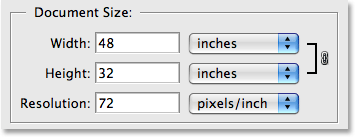PIXEL DIMENSIONS are the horizontal and vertical measurements of an image expressed in pixels. The pixel dimensions may be determined by multiplying both the width and the height by the dpi.
An 48" x 32" document that is scanned at 72 dpi has the
pixel dimensions of 3456 pixels (48" x 72 dpi) by 2304 pixels (32" x 72 dpi).
A digital camera will also have pixel dimensions, expressed as the number of pixels horizontally and vertically that define its resolution (e.g., 2,048 by 3,072).
Calculate the dpi achieved by dividing a document's dimension into the corresponding pixel dimension against which it is aligned.
RESOLUTION is the ability to distinguish fine spatial detail.
The spatial frequency at which a digital image is sampled (the sampling frequency)
is often a good indicator of resolution.
This is why dots-per-inch (dpi) or pixels-per-inch (PPI) are common and synonymous terms used to express resolution for digital images. Generally, but within limits, increasing the sampling frequency also helps to increase resolution.
DPI refers to the number of printed dots contained within one inch of an image printed by a printer. PPI refers to the number of pixels contained within one
the inch of an image displayed on a computer monitor.













No comments:
Post a Comment